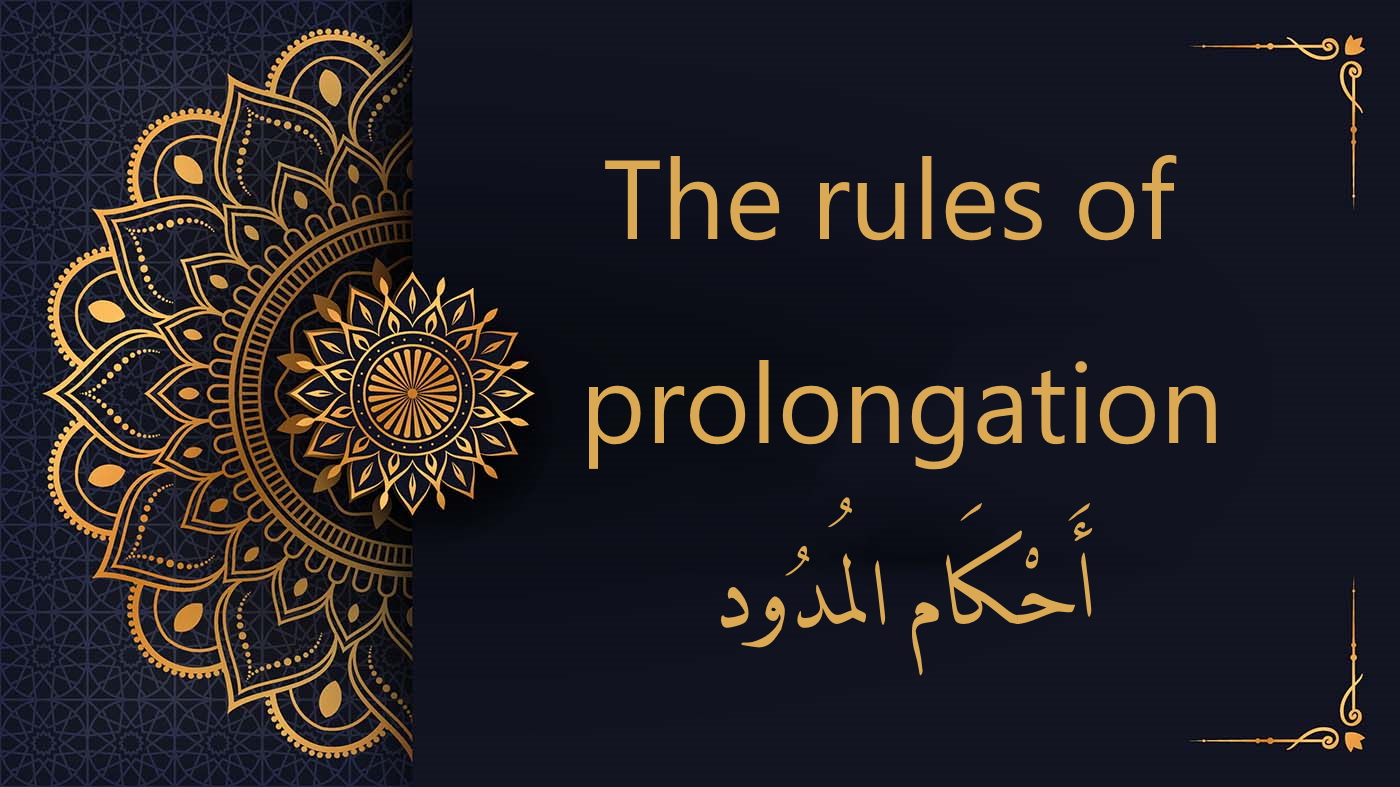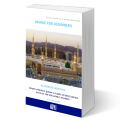
Tajweed Mastery: The Essentials of Prolongation Rules
In the realm of the Arabic language, the term “madd” is used, which can be translated as “extension” or “prolongation”.
Within the framework of Tajweed rules, “madd” refers to the elongation of a sound when pronouncing certain letters.
The Arabic script is characterized by:
-
Three short vowel marks or ‘harakat’:
- Fatha (ـَ)
- Damma (ـُ)
- Kasra (ـِ)
-
Accompanying these, there are three long vowel indicators, pertaining to the elongation or “madd” of sounds:
- The letter alif (ا) when following a consonant that carries the fatha; this can manifest as alif maqsûra (ى) or as a regular alif.
- The letter ya (ي) when following a consonant with a kasra; essentially, the letter ي itself.
- The letter waw (و) when it comes after a consonant with the damma, which is represented by the و itself.
These long vowel indicators can be observed in various verses of the Quran, exemplifying their significant role in Arabic phonetics and pronunciation.
In the Quran, a verse beautifully exemplifies the use of all long vowel indicators:
قَالَ الَّذِي عِندَهُ عِلْمٌ مِّنَ الْكِتَابِ
Said one who had knowledge from the Scripture (27:40)
Prolongations in Tajweed are systematically organized into two primary categories, further delineated into ten subcategories:
- Natural Prolongation (al madd al aslee): This encompasses four distinct subcategories.
- Conditional Prolongation (al madd al far’ee): Specifically associated with either a hamza (ء) or a sukoon, it branches out into six subcategories.
1. Fundamental Prolongation: المَدُّ الأَصْلِي
The Fundamental Prolongation, known as al madd al aslee, refers to an intrinsic elongation that arises independently, not influenced by the presence of a hamza (ء) or a sukoon.
By nature, it extends organically, distinguishing itself from the Conditional Prolongation – al madd al far’ee. The latter specifically elongates due to the intervention of a hamza (ء) or a sukoon.
The duration for this intrinsic elongation is consistently set at two counts, also known as harakatayn
A. Intrinsic Elongation: الْمَدُّ الأَصْلِي
The Intrinsic Elongation, termed as الْمَدُّ الأَصْلِي, is an elementary extension characterized by its unadorned nature and organic lengthening.
Distinctly, this elongation involves a long vowel that is not accompanied by either a hamza (ء) or a sukoon, before or after. The duration of this elongation consistently spans two counts, known as harakatayn, without exceeding this limit.
The pivotal letters forming the backbone of intrinsic elongation are Alif, Waw, and Ya:
ا – ي – و
This elongation manifests in three specific scenarios:
- When a consonant, bearing a short vowel fatha, precedes the Alif (ا).
- When a consonant, with the short vowel kasra, precedes the Ya (ي).
- When a consonant, carrying a short vowel damma, precedes the Waw (و).
صِرَاطَ الَّذِينَ أَنْعَمْتَ عَلَيْهِمْ غَيْرِ الْمَغْضُوبِ عَلَيْهِمْ وَلَا الضَّالِّينَ
The path of those upon whom You have bestowed favour, not of those who have evoked [Your] anger or of those who are astray. (1:7)
Observation: In certain versions of the mushaf, you may encounter the prolongation alif topped with a distinct circle. When presented with this notation, the elongation is reduced to a single count, rather than the typical two counts.
Example:

Nor will I be a worshipper of what you worship. (109:4)
Here, the Alif is not elongated.

So what yet causes you to deny the Recompense? (95:6)
At times, the circle atop the Alif may not be distinctly visible. In such instances, the elongation is executed for two counts.
B. Substitutive Elongation: المَدُّ الْبَدَلُ
When a hamza (ء) precedes the elongation marker, the duration of the vowel elongation is extended to two counts (harakatayn).
Examples
إِلَّا الَّذِينَ ءامَنُوا وَعَمِلُوا الصَّالِحَاتِ فَلَهُمْ أَجْرٌ غَيْرُ مَمْنُونٍ
So what yet causes you to deny the Recompense? (95:6)
عَلَّمَ الْقُرْآنَ
Taught the Qur’an, (55:2)
C. Minor Connective Elongation: الْمَدُّ الصِّلة صُغْرَى
Typically, when positioned at the end of a word, the letter Ha (ه) signifies the personal pronoun for the third person singular.
When the ه is preceded by a letter with a sukoon, a long vowel mark, or another letter that carries a sukoon, the pronunciation duration of the ه is confined to a single count (haraka)
Example:
رَّضِيَ اللَّـهُ عَنْهُمْ وَرَضُوا عَنْهُ ۚ ذَٰلِكَ لِمَنْ خَشِيَ رَبَّهُ
Allah being pleased with them and they with Him. That is for whoever has feared his Lord. (98:8)
Commonly, when the letter Ha (ه) appears at the end of a word, it stands as the personal pronoun for the third person singular.
If the ه is preceded by a letter that has a sukoon, a long vowel mark, or another letter with a sukoon, its pronunciation is limited to a single count (haraka).
However, the letter’s elongation spans two counts when it isn’t succeeded by a hamza (ء), with three notable exceptions:
- When it follows a letter of prolongation.
- When the preceding letter has a sukoon.
- When the Ha (ه) itself carries a sukoon.
Example:
فَأَثَرْنَ بِهِ نَقْعًا
Stirring up thereby [clouds of] dust, (100:4)
Observations on Madd as-Sila Sughra:
In various editions of the mushaf, one may observe a diminutive comma or loop adjacent to the letter ه. The specific annotation—whether a comma or loop—often depends on whether the ه is vocalized with a kasra or damma. This marking indicates the third person singular masculine pronoun, signaling the reader to elongate the pronunciation for two counts (harakatayn).
For instance, in Surah Al-Adiyat, verse 4, the ه is elongated with a kasra as seen in هِ:

Example sura Al Balad verse 8, prolongation of ه with a damma ُه:

Have We not made for him two eyes? (90:8)
Exceptions to the Madd as-Sila Sughra Rule:
While general rules govern the elongation of the letter ه, it’s important to note that the Holy Qur’an sometimes presents exceptions to these conventions. The Qur’an, in its linguistic depth and divine wisdom, has its distinct phonetic and structural features, emphasizing the importance of accurate recitation. Such intricacies reinforce the uniqueness of the Qur’an and highlight the significance of studying Tajweed for a correct understanding and pronunciation.
Examples:
قَالُوا أَرْجِهْ وَأَخَاهُ وَأَرْسِلْ فِي الْمَدَائِنِ حَاشِرِينَ
They said, “Postpone [the matter of] him and his brother and send among the cities gatherers (7:111)
يُضَاعَفْ لَهُ الْعَذَابُ يَوْمَ الْقِيَامَةِ وَيَخْلُدْ فِيهِ مُهَانًا
Multiplied for him is the punishment on the Day of Resurrection, and he will abide therein humiliated – (25:69)
وَإِن تَشْكُرُوا يَرْضَهُ لَكُمْ
And if you are grateful, He approves it for you (39:7)
كَلَّا لَئِن لَّمْ يَنتَهِ لَنَسْفَعًا بِالنَّاصِيَةِ
No! If he does not desist, We will surely drag him by the forelock – (96:15)
Subtleties in Applying the Madd as-Sila Sughra Rule in the Holy Qur’an:
While the Madd as-Sila Sughra rule generally mandates that the pronoun ه should be preceded by a vocalized (mutaharika) letter for elongation, there are instances in the Qur’an where this criterion is not strictly adhered to.
The Qur’an, with its profound linguistic layers and divine orchestration, sometimes deviates from conventional Tajweed norms. Such deviations not only emphasize the rich tapestry of the Qur’anic Arabic but also underscore the importance of in-depth Tajweed study to ensure proper recitation. It’s essential to approach the Qur’an with both understanding and respect for these specialized rules and their occasional exceptions.
Example:
يُضَاعَفْ لَهُ الْعَذَابُ يَوْمَ الْقِيَامَةِ وَيَخْلُدْ فِيهِ مُهَانًا
Multiplied for him is the punishment on the Day of Resurrection, and he will abide therein humiliated – (25:69)
D. Stabilizing Elongation: الَمَدُّ التَّمْكِيْن
Insights on the Stabilizing Elongation: الَمَدُّ التَّمْكِيْن
When two identical letters, either yâ (ي) or waw (و), succeed each other, and one of them serves as a letter of prolongation (like a yâ following a kasra or a waw following a damma), a distinctive articulation is required. Specifically, the elongation of the yâ or waw should be maintained for two counts (harakatayn).
It’s crucial to ensure this distinct elongation to prevent assimilation (known as al idgham) between the two letters. The emphasis on this separation reinforces the nuanced beauty and precision of Qur’anic recitation, preserving the unique sound and meaning of each word.
Examples:
وَإِذَا حُيِّيتُم بِتَحِيَّةٍ فَحَيُّوا بِأَحْسَنَ مِنْهَا أَوْ رُدُّوهَا
And when you are greeted with a greeting, greet [in return] with one better than it or [at least] return it [in a like manner] (4:86)
إِنَّ الَّذِينَ آمَنُوا وَعَمِلُوا الصَّالِحَاتِ
Indeed, those who believe and do righteous deeds (2:277)
2. Conditional Elongation: الْمَدُّ الْفَرْعِي
When the elongation is succeeded by the letter hamza (ء), there are three distinct scenarios:
A. Compulsory Conjoined Elongation: الْمَدُّ الْوَاجِبُ المُتَّصِل
In instances within a single word where the elongation precedes the letter hamza (ء), the pronunciation can be extended for either four or five counts.
Example:
الَّذِينَ هُمْ يُرَاءُونَ
Those who make show [of their deeds] (107:6)
Insights on the Compulsory Conjoined Elongation:
-
Mandatory Application: It’s vital to note that applying this elongation is not optional; it’s a compulsory aspect of correct recitation.
-
Consistency in Count: While there’s flexibility in choosing between four or five counts for this elongation, it’s beneficial to remain consistent with your chosen count throughout the recitation. This consistency helps maintain rhythmic harmony and clarity in the recitation.
-
Mushaf Annotations: In some versions of the mushaf, a distinctive wavy symbol placed above the letter indicates this specific elongation, signaling the reader that a four or five count elongation is required. Familiarizing oneself with these annotations is invaluable for ensuring accurate Qur’anic recitation.
Example:
![]()
And your Lord has come and the angels, rank upon rank, (89:22)
B. Optional Detached Elongation: الْمَدُّ الْجَائِز الْمُنْفَصِلُ
Insights on the Optional Detached Elongation: الْمَدُّ الْجَائِز الْمُنْفَصِلُ
The Optional Detached Elongation occurs when the elongation is situated at the end of one word, and the subsequent word starts with the hamza (ء) letter.
-
Duration of Elongation: In such cases, the reader has the choice to extend the pronunciation for either four or five counts. However, in specific readings or traditions, only a two-count elongation might be prescribed.
-
Significance: This rule showcases the phonetic intricacy and rhythmic beauty of the Qur’anic recitation. The variation in the elongation counts, depending on the reading tradition, emphasizes the depth and breadth of the Qur’anic oral tradition.
Example:
لَا أَعْبُدُ مَا تَعْبُدُونَ
I do not worship what you worship. (109:2)
Insight on Mushaf Annotations for the Optional Detached Elongation:
In the realm of Qur’anic recitation, annotations and symbols in the mushaf play an essential role in guiding the reader through the intricate nuances of Tajweed.
-
Wave Symbol: Specifically, in several versions of the mushaf, a subtle wavy line positioned above a letter indicates the necessity for elongation. This wavy symbol serves as a visual cue for the reader, signaling that an elongation of either four or five counts is warranted at that specific juncture.
-
Purpose: These annotations, like the wavy symbol for prolongation, ensure that the divine scripture is recited with the precision and respect it deserves. Familiarity with these symbols is instrumental for anyone aiming for an accurate and melodious Qur’anic recitation.
Example:

But when He tries him and restricts his provision, he says, “My Lord has humiliated me.” (89:16)
C. The Grand Detached Elongation: الْمَدُّ الضِّلَة كُبْرَى
Insights on the Grand Detached Elongation: الْمَدُّ الضِّلَة كُبْرَى
This elongation is particularly interesting due to its association with the masculine pronoun هُ in Arabic.
-
Context of Occurrence: The Grand Detached Elongation comes into play when the masculine pronoun هُ is immediately followed by the letter hamza (ء). In such scenarios, the reader is guided to elongate the sound.
-
Duration of Elongation: The prescribed elongation can span either four or five counts. The choice between these counts gives some flexibility to the reader, but it’s essential to be aware of traditional preferences.
-
Scholarly Preference: Notably, many eminent scholars and experts in Qur’anic recitation (Ulemas) express a preference for the four-count elongation over the five-count in such cases. Their guidance is grounded in the traditions and established norms of Tajweed, aiming for a recitation that resonates with historical authenticity and melodic precision.
-
Significance: Such nuances highlight the depth of the Qur’anic recitation tradition. Every sound, every elongation, is carefully considered to convey the intended meaning and beauty of the divine message. Adhering to these details ensures that the scripture is recited with the reverence and accuracy it warrants.
Example:
يَحْسَبُ أَنَّ مَالَهُ أَخْلَدَهُ
He thinks that his wealth will make him immortal. (104:3)
Annotation Insights for the Grand Detached Elongation: الْمَدُّ الضِّلَة كُبْرَى
The Qur’anic mushaf is meticulously annotated with symbols and markings to aid readers in accurate recitation and understanding of Tajweed rules.
-
Wave Symbol: In various editions of the mushaf, a wavy line (similar to a tilde) positioned above a miniature waw (و) or beside a small comma near the letter ه serves as a visual guide. This specific annotation points to the occurrence of the Grand Detached Elongation associated with the third person masculine singular pronoun.
-
Purpose of the Mark: This symbol is not merely decorative; it holds significant instructional value. The wave directs the reader to elongate the associated sound for either four or five counts when reciting. Given the scholarly preference for a four-count elongation, this mark serves as a crucial reminder for the reader to adhere to the nuances of Tajweed.
-
Preservation of Tradition: Such annotations in the mushaf are a testament to the profound efforts taken historically to ensure that the Qur’an’s recitation remains consistent and precise. By following these marks, readers can align their recitation with the time-honored traditions and standards set by experts in Qur’anic phonetics.
Example:

He thinks that his wealth will make him immortal. (104:3)
D. Three Instances Where Prolongation Precedes a Sukoon
The Temporary Pause Elongation: الْمَدُّ العارِضُ السُّكُون
This form of elongation occurs when a sukoon follows a prolongation, and it’s necessitated by pausing during recitation. The length of the elongation varies, influenced by the pacing of the reader:
-
Dynamic Elongation: The madd (elongation) is adaptive and varies depending on the reading’s tempo.
-
Count Durations:
- Brief Recitation: When one is reading quickly, the elongation spans two beats.
- Moderate Recitation: At a medium pace, the prolongation extends to four beats.
- Deliberate Recitation: In a slow and contemplative recitation, the reader stretches the elongation to six beats.
-
Practical Application: These variable lengths cater to different contexts of recitation. For instance, during regular daily recitations, one might opt for a quicker pace, but during a more meditative or ceremonial reading, extending the prolongations can add depth and resonance to the recitation.
-
Purpose: The flexibility in this rule ensures the Qur’an’s recitation remains fluid and adaptable to various circumstances while still adhering to the guidelines of Tajweed.
Example:
بِسْمِ اللَّـهِ الرَّحْمَـٰنِ الرَّحِيمِ
In the name of Allah, the Entirely Merciful, the Especially Merciful. (1:1)
The Soft Elongation: الْمَدُّ اللِّين
This type of elongation arises when one pauses on a word where the second-to-last letter is either a waw و or ya ي. This letter carries a sukoon and is directly preceded by a letter with a fatha. The soft nature of these letters allows for a gentle extension in their pronunciation during such instances.
-
Variable Length: Much like the previous rule, the duration of this elongation varies according to the reader’s pace.
-
Count Durations:
- Brief Recitation: In a swift reading, the elongation is two beats.
- Moderate Recitation: For a medium-paced reading, it extends to four beats.
- Deliberate Recitation: When recited slowly and with contemplation, the elongation can stretch up to six beats.
-
Purpose: This rule emphasizes the softness and flexibility inherent in the Arabic letters waw and ya, especially when they appear in the mentioned configuration. This adaptive elongation enhances the beauty and rhythm of the Qur’anic recitation.
-
Consideration: It’s essential for readers to be aware of such nuances, as they not only impact the aesthetics of the recitation but also ensure adherence to the intricacies of Tajweed.
Example:
لِإِيلَافِ قُرَيْشٍ
For the accustomed security of the Quraysh – (106:1)
The Compulsory Extension: الْمَدُّ الَّازِم
This elongation occurs when an obligatory sukoon follows a letter of prolongation within a single word. The significance of this rule lies in its strict and compulsory nature.
-
Duration: It is mandatory to extend this elongation for precisely 6 beats. It’s crucial for readers to strictly adhere to this duration to maintain the integrity of the recitation.
-
Visualization in the Mushaf: For the ease of reciters and to emphasize the importance of this rule, some editions of the mushaf denote this 6-beat prolongation with a small wave sign above the respective letter. This serves as a visual guide, ensuring that the reader is reminded of the required elongation.
-
Purpose: The strictness of this rule underscores its significance in preserving the rhythm and melody inherent in the Qur’anic verses. By observing this compulsory extension, readers ensure they convey the intended flow and harmony of the text.
-
Mastery: As with other tajweed rules, mastering the Compulsory Extension requires dedicated practice and attention to detail. Over time, this elongation becomes an integral part of a reader’s recitation style, enhancing their connection with the Divine text.
Examples:

or of those who are astray. (1:7)
![]()
Alif, Lam, Meem. (2:1)
Al madd al lazeem is divided into four categories:
3. The Compulsory Extension: الْمَدُّ الَّازِم
A. The Weighted Compulsory Word-Based Extension: الْمَدُّ الَّازِم الكَلِمي المُثَّقَل
In this type of prolongation, the emphasis is within a single word. The term “muthaqqal” in Arabic translates to “weighted” or “heavy.”
Specifically, this occurs when the prolonged letter is immediately followed by a letter with a shadda (doubled consonant) within the same word. This shadda signifies the intensity or emphasis of the consonant, adding depth to the pronunciation. This weighted pronunciation adds a unique rhythm and cadence to the word, enhancing the beauty of its recitation.
Example:

or of those who are astray. (1:7)
B. The Lightened Compulsory Word-Based Extension: الْمَدُّ الَّازِم الْكَلِمي المُخَّفَف
This type of prolongation is unique in its occurrence and application. In Arabic, “mukhaffaf” translates to “lightened” or “relieved.”
When this rule is applied, it means that a letter of prolongation is followed by a sukoon within the same word. What’s particularly intriguing about this rule is its rarity: it can only be found twice in the entirety of the Holy Qur’an. Both instances occur with the word آلْآنَ, which translates to “now.” Both appearances of this unique word and its associated rule can be found in the Sura Yunus. Readers and students of the Qur’an are advised to take note of this exception and pay special attention when encountering it.
أَثُمَّ إِذَا مَا وَقَعَ آمَنتُم بِهِ ۚ آلْآنَ وَقَدْ كُنتُم بِهِ تَسْتَعْجِلُونَ
Then is it that when it has [actually] occurred, you will believe in it? Now? And you were [once] for it impatient (10:51)
آلْآنَ وَقَدْ عَصَيْتَ قَبْلُ وَكُنتَ مِنَ الْمُفْسِدِينَ
Now? And you had disobeyed [Him] before and were of the corrupters? (10:91)
Note:An interesting observation can be made with the word آلْآنَ. While it appears in both Sura Yunus and Sura Yousuf (verse 51), its application differs based on the context. In Sura Yousuf, the term آلْآنَ is utilized in an affirmative statement rather than an interrogative one.
Due to this distinction, we do not employ the rule of “madd al lazeem al kalimee al mukhaffaf” in Sura Yousuf’s context. Instead, because the prolongation is immediately preceded by a hamza ء, we apply the rule of “madd al Badal,” which prescribes a prolongation of 2 beats. It’s essential for readers and scholars to be cognizant of these nuanced distinctions in the Qur’anic text to ensure accurate recitation and understanding.
قَالَتِ امْرَأَتُ الْعَزِيزِ الْآنَ حَصْحَصَ الْحَقُّ أَنَا رَاوَدتُّهُ عَن نَّفْسِهِ وَإِنَّهُ لَمِنَ الصَّادِقِينَ
The wife of al-‘Azeez said, “Now the truth has become evident. It was I who sought to seduce him, and indeed, he is of the truthful. (12:51)
C. Obligatory Letter-based Prolongation (Emphasized) - المَدُّ اللَّازِم الحَرْفِي المُثَّقَّل
The emphasized letter-based prolongation focuses on individual letters, and as the term “muthaqqal” suggests in Arabic, it refers to a weighty or emphasized sound. This unique form of prolongation is prominently observed in certain letters that mark the commencement of various Surahs in the Qur’an.
To better understand this concept, consider the structure of these letters when they are vocalized and expanded. They encompass three distinct letters, with the central one being a long vowel, followed by a third letter that gets emphasized by merging into the subsequent letter.
For this specific form of prolongation to be executed correctly, it should satisfy three prerequisites:
- The letter in its written form is constituted of three distinct phonemes. For instance, Lam (ل).
- Among these, the central phoneme must represent a long vowel. Once again, referring to Lam (ل).
- The third phoneme seamlessly merges (idgham) with the following one, exemplified by the sequence Lam Meem.
Thus, upon writing the letter as it gets pronounced, one can clearly observe a shadda succeeding the letter of prolongation.
Examples:
The combination الم, when expanded phonetically, reads as أَلِف لامِّ مِيْم. During recitation, it would sound like: [Here, the recitation is to be provided or continued.]
Note: Remember, the application of the correct pronunciation and prolongation is vital to ensure the essence and beauty of the Qur’an’s verses are maintained.
![]()
Alif, Lam, Meem. (2:1)
طسم is pronounced طَا سِين يمِّيم and recitated:
طسم
Ta, Seen, Meem. (26:1)
D. Essential Lightweight Articulation - المد اللازم الحرفي المخفف
Madd Al-Mukhaffaf: Understanding the Nuances of Arabic Letter Prolongation
In the intricacies of Arabic pronunciation, the phenomenon known as “madd al-mukhaffaf” plays a significant role. This term refers to a particular type of letter prolongation that centers on a single letter within a word. In the Arabic language, “mukhaffaf” translates to “light,” which aptly describes the nature of this elongation.
When we delve into the specifics, we find that madd al-mukhaffaf is observed in individual letters, and its pronunciation includes three distinct elements, often with a long vowel sandwiched between unvocalized consonants.
The underlying rule governing madd al-mukhaffaf remains consistent with other madd types, with only the third condition differing from the standard rules:
-
Letter Composition: The letter in question must be composed of three distinct letters. For example, the Arabic letter “ق” (Qaf) satisfies this condition.
-
Middle Letter Long Vowel: The crucial feature of madd al-mukhaffaf is the presence of a long vowel sound positioned in the middle of the word. This long vowel disrupts the flow of otherwise unvocalized consonants. For instance, “ق” (Qaf) would be pronounced as “قُوْ” (Qoo), where the elongated “و” (oo) represents the middle long vowel sound.
-
No Assimilation with Following Letter: Importantly, the third letter within the composition must not undergo assimilation into the following letter. In the case of “ق” (Qaf), it remains distinct and does not blend with the subsequent letter.
To illustrate this concept further, consider the Arabic letter “ن” (Nun). When applying madd al-mukhaffaf, it transforms as follows:
- Standard Pronunciation: “ن” (Nun)
- Madd Al-Mukhaffaf Pronunciation: “نُوْن” (Noon)
Here, we see how the otherwise single letter “ن” (Nun) experiences letter prolongation when adhering to the rules of madd al-mukhaffaf. The transformation from “ن” to “نُوْن” exemplifies the inclusion of a middle long vowel sound and the preservation of distinct phonetic elements within the word.
In summary, madd al-mukhaffaf is a fascinating aspect of Arabic phonetics, and understanding its rules can greatly enhance one’s grasp of proper pronunciation in the Arabic language. By recognizing the specific conditions governing this phenomenon, learners and enthusiasts alike can master the art of letter prolongation with precision and accuracy.
ن
Nun (68:1)
ق is pronounced قَاف:
ق
Qaf (50:1)
يس is pronounced يا سين:
يس
Ya, seen (36:1)
E. Distinguishing Madd: Al Madd al Farqee - المد الفرقي
The Significance of Sextuple Prolongation (Madd al-Farqee) in Arabic
In the realm of Arabic phonetics, a fascinating phenomenon known as “Madd al-Farqee” takes center stage. This particular type of prolongation occurs not just once, but six times within specific linguistic contexts. Understanding Madd al-Farqee is crucial, as it serves a distinctive purpose in the Arabic language—namely, to differentiate between interrogative forms that utilize the interrogative particles of the affirmative form when coupled with “hamzatu al-khabaree.”
This linguistic quirk carries significant importance in Arabic grammar. To grasp its essence, it’s essential to recognize the critical role it plays in distinguishing between two fundamental sentence structures:
-
Interrogative Form: In Arabic, questions often incorporate interrogative particles. Madd al-Farqee, with its sixfold prolongation, comes into play here to indicate that a sentence is, indeed, a question. This extended prolongation marks the sentence as interrogative.
-
Affirmative Form’s Interrogation Particles with Hamzatu al-Khabaree: In some cases, the Arabic language employs interrogation particles derived from the affirmative form when coupled with “hamzatu al-khabaree.” These particles, in conjunction with Madd al-Farqee, help clarify that a question is being posed, even when using the vocabulary of an affirmative statement.
The significance of Madd al-Farqee becomes evident when we consider the subtle nuances of Arabic grammar and the precision required for effective communication. It is a linguistic tool that enhances clarity and ensures that interrogative sentences are unmistakably distinguished from declarative ones, even when using similar vocabulary.
In summary, Madd al-Farqee, with its sixfold prolongation, serves as a distinctive feature in Arabic phonetics and grammar. Its role is to help differentiate interrogative forms that employ the vocabulary of affirmative sentences when paired with “hamzatu al-khabaree.” This linguistic subtlety is a testament to the intricacies and precision of the Arabic language, ensuring clear and unambiguous communication in various contexts.
Examples:
قُلْ آلذَّكَرَيْنِ حَرَّمَ أَمِ الْأُنثَيَيْنِ أَمَّا اشْتَمَلَتْ عَلَيْهِ أَرْحَامُ الْأُنثَيَيْ
Say, “Is it the two males He has forbidden or the two females or that which the wombs of the two females contain? (6:143)
قُلْ آللَّـهُ أَذِنَ لَكُمْ
Say, “Has Allah permitted you [to do so] (10:59)
آللَّـهُ خَيْرٌ أَمَّا يُشْرِكُونَ
Is Allah better or what they associate with Him?” (27:59)
Conclusion
This Tajweed rules lesson has concluded. Insha’Allah, the next lesson will cover the rules of Qalqala.
At the Al-dirassa Institute, we provide an accessible path to mastering Tajweed under the guidance of skilled instructors. Should you wish to pursue this further, we warmly invite you to reach out to us.
Chosen and Trusted by Thousands of Satisfied Learners
Discover the experiences of our delighted clients who have thoroughly enjoyed utilizing this standout feature.
Alhamdulillah I‘m very pleased with the arabic and Qur’an lessons I receive from teacher Umm Tasneem and I‘m also content with the al-dirassa administration team who were very quick in answering any questions I had. In a month I progressed a lot and I cannot wait to continue my studies with al-dirassa. May Allah reward everyone at al-dirassa.
 Verified review - view original
Verified review - view original
My Qur’an teacher is fantastic, she teaches me in a loving and kind way where I look forward to the lessons and learn so much. My Arabic teacher is equally as nice and has a lot of patience with me, she has great expertise in the field and I’ve progressed really quickly with her. Thank you Al-dirassa!
 Verified review - view original
Verified review - view original
Book your free trial lesson
Don’t want to go through the translation anymore?
30 free minutes with your qualified Egyptian teacher.




